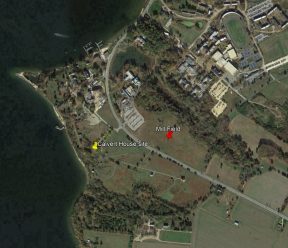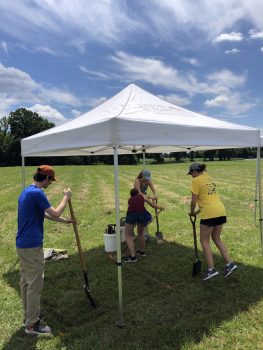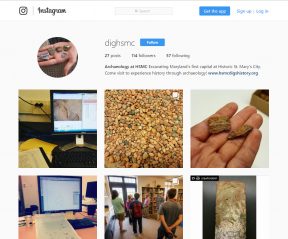Back to Dispatches from Field School
Field School 2019 – Week 1
Travis Parno — HSMC Director of Research and Collections
“The 2019 Field Season Begins!”
We’ve turned around and found ourselves at the beginning of another field school season! This year we’ve welcomed 12 students from throughout Maryland and beyond to learn the theory and methods of field archaeology in our 2019 Field School in Historical Archaeology. We’re excited to get to work and share what we learn about the history of Maryland’s first capital with you!
This year the field school is operating somewhat differently: rather than spending our ten weeks on a single site, we’ll be dividing our summer across two different sites. For the first five weeks of the season, we’ll be working in an area known as the Mill Field. Because the Mill Field is a challenge to access, the site will not be open for visitation. For the second five weeks (including our annual Tidewater Archaeology Weekend program on July 20-21), we’ll return to the Calvert House to work in closer proximity to the visiting public and to address some lingering questions from previous field seasons.
The Mill Field is an area adjacent to Maryland Rt. 5 and Mattapany Road where previous study has found artifacts spanning the entire 17th century. The site was surface collected in the mid-1980s and excavated more intensively in 1992. The results of these studies suggest that Mill Field holds the remains of important late 17th-century sites that were occupied during the historic capital’s peak. More recently, a geophysical survey that combined magnetometry and ground-penetrating radar identified multiple areas of high intensity burning. These may be signs of Native America hearths or early metalworking. We’re hoping our work at the site will reveal additional information about this exciting and understudied portion of the National Historic Landmark.
In July, we’ll return to the Calvert House site, a fascinating property that includes the buried (and since partially reconstructed) remains of Leonard Calvert’s home. Construction of the building began in the mid-1630s. Originally, the home was probably a modest hall-and-parlor house with a central fireplace, but soon it was expanded to become one of the largest timber-frame houses in early Maryland. The Calvert House was home to multiple residents following Leonard Calvert’s death in 1647, but by the early 1660s, it took on a new role as the Country’s House, so named because it was owned by the colony (or “Country”) and functioned as the first official statehouse of Maryland. Because it wasn’t needed as a governmental meeting space year-round, the building was leased as an “ordinary” or inn, and thus doubled as a place where visitors and travelers could rest and enjoy a warm meal.
After the construction of the new brick statehouse in 1676, the colony’s official use of the Calvert (or Country’s) House declined. Documentary records tell us that by the end of the 17th century, the structure was sorely in need of repairs and, following the move of Maryland’s capital to what would become Annapolis, it fell into disuse. In 1841, Dr. John Brome built a large plantation house over the buried foundations of the Calvert House and Dr. Brome, his family, and their servants and slaves lived on the property for many years. Dr. Brome’s house was moved down to Rosecroft Road in 1994 and now functions as an inn. A surviving duplex slave quarter from the Brome family era was also relocated and recently reopened as an exhibit documenting the lives of Africans and African Americans in St. Mary’s County in the 19th and 20th centuries.
Our goals at the Calvert House include a return to the property’s north yard to search for evidence of outbuildings that would have supported the main structure. We will be revisiting excavation units that were started last summer to continue our investigation of a series of large post holes found in the yard. We will also be returning to an interesting feature located just southwest of the Calvert House foundations. Excavations in previous seasons have shown that in the 17th century this area was a ravine that had been filled at some point in the property’s history. The feature yielded a high level of animal bones, or faunal material in archaeological parlance. We aim to excavate another section of the ravine to determine if we can refine our understanding of when and how this ravine was filled. It should yield some exciting results!
But before our students could put shovels and trowels to the soil, they needed to first learn about the history of St. Mary’s City, as well as some of the fundamentals of excavation methods and archaeological artifact identification.
Our team spent their first day hearing about the history of historical and archaeological research at Historic St. Mary’s City, before heading out onto the landscape for a tour of our many interpretive sites. For the next two days, the students learned about 17th– and 18th-century ceramics, examining examples of some of the many types of pottery that we find on our sites. They also received foundational instruction in the basics of archaeological field methods. As we always teach, archaeologists typically collect the same types of data, but each institution has its own specific manner of collecting that data. The HSMC way requires meticulous attention to detail and exhaustive documentation. We’re very much aware of our responsibility to the citizens of Maryland, and the entire United States, as we excavate the remains of the state’s first capital in this National Historic Landmark.
On day four of our first week, we headed out to the Mill Field to begin our fieldwork! Much like their time in the laboratory, the students reviewed some necessary information before diving into the excavation process. They learned our basic site policies, toured the excavation trailer, became familiar with the various tools they would use on-site each day, and practiced setting up our pop-up tents.
Once the introductory steps were completed, we began our fieldwork. We targeted three 5′×10′ areas near an area where the 1992 excavations found 17th-century artifacts and features. The sod and upper soils in the Mill Field are quite firm so our students were quickly introduced to the importance of good shovel techniques. In the initial hours of the day, very few artifacts came out of the units, but by the end of the afternoon, the students had identified Rhenish blue-and-gray stoneware, wrought and cut nail parts, a European tobacco pipe stem, and an assortment of brick fragments. Some complaints were raised when I suggested we stop for a water break, so the enthusiasm levels are high! It seems clear that these few remnants have stoked excitement for what will surely be a productive and fun summer filled with lots of fascinating finds!
As we continue our work over the next nine weeks of the program, continue checking our website, Facebook page, and Instagram feed (@digHSMC) for more coverage of the field school’s progress. In the coming weeks, you’ll hear first-hand from our students as they describe their experiences excavating the history of Maryland’s first capital. We can’t wait to see what they find…





